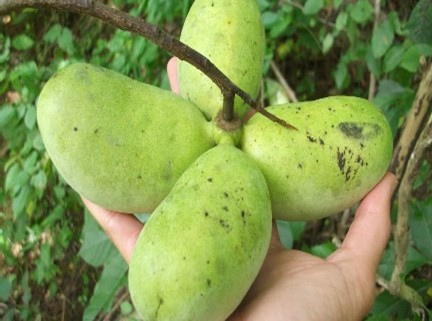Over The Garden Wall PAWPAW – America’s Forgotten Fruit

Excerpted from BBC TRAVEL
North America’s largest native edible tree fruit grows wild in 26 US states, including Texas, Ohio, West Virginia, New York and Michigan and all the way up to Ontario, Canada. Yet few have ever heard of it.
Pawpaws have never been sold on a large scale. Commercial farmers shun them because they need a special growing environment of low, wet areas and because they spoil only a few days after harvest – so you won’t see the yellow-green fruit next to the grapes at the grocery store. Nevertheless, a community of avid pawpaw fans across the US – from festival organizers and chefs to scientists and independent farmers – is expanding the love for this forgotten fruit, and they want you to love it too.
“They are so delicious,” said Michael Judd, author of For the Love of Paw Paws: A Mini Manual for Growing and Caring for Paw Paws – From Seed to Table. During the harvest season (typically a few weeks in late summer or early autumn), his diet consists mainly of pawpaws taken right off the branch. “It’s a nutrient-rich superfood,” he added, listing off the pawpaw’s many attributes: antioxidants, all the amino acids, magnesium, copper, zinc, iron, potassium, phosphorus, vitamin C.
The pawpaw is in the same family as the custard apple, cherimoya, sweetsop, soursop and ylang-ylang. It’s a subtropical fruit that migrated north from Central America, and it is atypical; the only member of the family not confined to the tropics.
The earliest fossil evidence of pawpaws originated in the Miocene Epoch, about 23 to 5.3 million years ago in what is now Colorado. Over time, the climate has had warming periods, expanding the range of tropical areas north and, by extension, the pawpaw. Additionally, scientists have hypothesized that pawpaws were dispersed northward by megafauna, like mastodons, mammoths and sloths, saber-toothed cats and giant beavers.
There is evidence that humans played a role in pawpaw dispersal as well. “Natives in the eastern half of the country have always used pawpaws,” said Dr Devon Mihesuah, a citizen of the Choctaw Nation who holds the Cora Lee Beers Price professorship in International Cultural Understanding at the University of Kansas. “Iroquois reportedly mashed pawpaws and made the flesh into cakes and then dried them in the sun. They were used as a travel food or mixed with water into cornbread.”
In 1541, Spanish explorer Hernando de Soto took note of Native Americans cultivating it east of the Mississippi River. George Washington wrote in his diary in 1785: “Planted all my cedars, all my pawpaw, and two honey locust trees.” (Though there’s no historical documentation, it is said chilled pawpaw was Washington’s favourite dessert.) In 1786, when Thomas Jefferson was minister to France, he had pawpaw seeds and plants shipped from Virginia to friends in Europe. A journal entry from the explorers Lewis and Clark dated 18 September 1806 recorded that the men were “entirely out of provisions” but “appear perfectly contented”, living “very well on the pawpaws.”
The fruit’s texture has been compared to custard, and the flavor is “a blend of banana and mango, with undertones of vanilla, caramel, pineapple, coconut and melon, depending on the cultivar”, said Sheri Crabtree, a horticulture and research extension associate at Kentucky State University’s pawpaw research program.
Many an aficionado will tell you that the mango-shaped orbs – yellow-green on the outside with gold-orange flesh, and 3 to 5 inches long with a weight of up to 18 ounces – are best enjoyed hand-picked off the tree. But for now, it’s impossible to find them at a local grocery store; instead, farmers sell the fresh fruit or its frozen pulp online direct to consumers or at local farmer’s markets. Pawpaw trees are also sold by nurseries.
Kentucky State University has a pawpaw program. “We’re interested in pawpaw from an ecological standpoint as a native plant that is losing habitat, and from a horticultural standpoint as a unique high-value fruit crop that can be grown sustainably since it’s well suited for the climate,” said Crabtree. She noted that over the past 20 years she’s seen awareness of the fruit grow, driven by the shift toward sustainable and local food production and the Slow Food movement. Some of that attention is also driven by efforts to honor indigenous foods. As Mihesuah pointed out, “Tribes are attempting to protect and revitalize their traditional food sources, and pawpaws are an important part.”
Chef and culinary educator Sara Bir recently wrote The Pocket Pawpaw Cookbook. “At their best, pawpaws are custardy. Therefore, I love them in baked custards and chilled, dairy-based desserts,” she said. “They also do well in tropically inspired savory foods – a pawpaw beurre blanc spiked with habanero pepper to serve with shrimp, say.” And Minnesota-based chef Alan Bergo, a noted forager and hunter of obscure wild foods, has taken a shine to the fruit, sharing recipes for pawpaw panna cotta and pawpaw cheesecake on his website.
It’s an enthusiastic collection of industrious individuals eager to put the pawpaw on a bigger stage. George Washington would be pleased.
BBC Travel’s Forgotten Foods offers hope for the world’s “lost” foods through chefs and purveyors who are bringing them back to life through cooking and cultivation.
